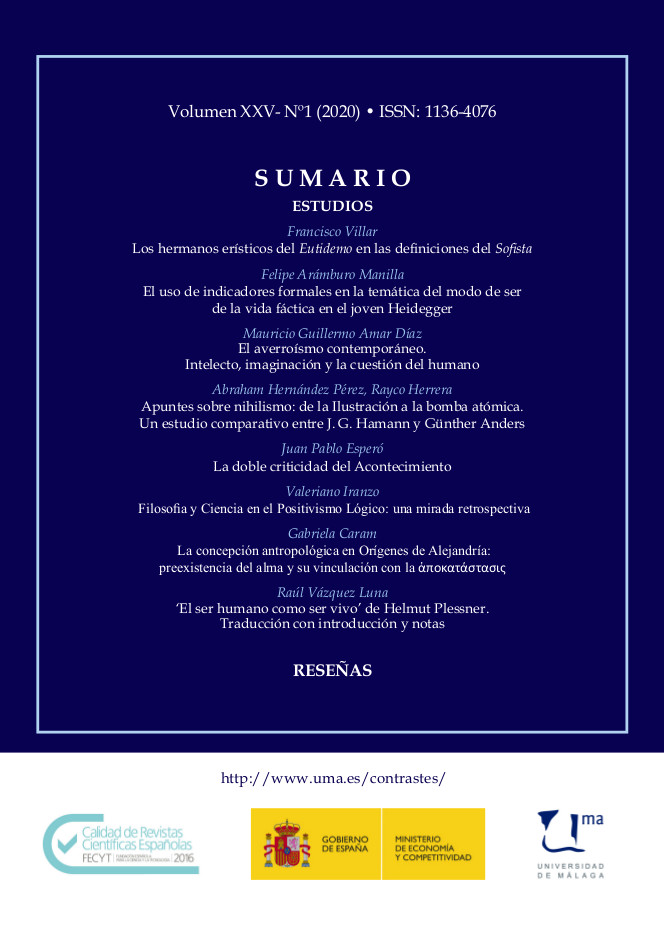Los hermanos erísticos del Eutidemo en las definiciones del Sofista
DOI:
https://doi.org/10.24310/Contrastescontrastes.v25i1.6469Palabras clave:
Platón, sofista, erística, dialéctica, refutaciónResumen
En este trabajo defenderé que los erísticos del Eutidemo se dedican a la sofística tal como esta es definida en el Sofista. Propondré que en tanto la quinta y la séptima definición se sirven del concepto de ???????????, ambas son capaces de capturar el componente dialéctico y refutativo de la práctica erística. Preferiré indentificarlos con la séptima no sólo porque constituye la definición final del sofista, sino también porque esta incluye entre sus determinaciones el empleo engañoso de tal forma de argumentación, rasgo que se ajusta más a la erística que el cobro de dinero, elemento principal de la quinta.
Descargas
Métricas
Publicación Facts
Perfil de revisores N/D
Información adicional autores
Indexado: {$indexList}
-
Indexado en
- Sociedad Académica/Grupo
- N/D
- Editora:
- Universidad de Málaga
Citas
BURNET, J. (1995): Platonis Opera I. Oxford: Oxford University Press.
CANTO, M. (1989): Platon. Euthydème. Paris: Flammarion.
CHANCE, T. (1992): Plato’s Euthydemus: Analysis of What Is and Is Not Philosophy. Berkeley-Los Angeles, University of California Press.
CHANTRAINE, P. (1968): Dictionnaire Étymologique de la langue grecque. Histoire des mots. Paris: Klincksieck.
CLASSEN, C. J. (1979): “Aristotle’s picture of the sophists”. En G. B. Kerferd (Ed.). The Sophists and Their Legacy. Wiesbaden: Franz Steiner Verlag Gmbh, pp. 7-24.
CORDERO, N. (1988): Platón. Sofista. Madrid: Gredos.
CORNFORD, F. M. (1935): Plato’s Theory of Knowledge. London: Routledge y Kegan Paul.
CROMBIE, I. M. (1963): An Examination of Plato's Doctrines. Vol. II. Routledge y Kegan Paul: Londres.
DENYER, N. (1991): Language, Thought and Falsehook in Ancient Greek Philosophy. Londres-New York: Routledge.
DORION, L. A. (1995): Aristote. Les réfutations sophistiques. Paris: Vrin.
DORION, L. A. (2000): “Euthydème et Dionysodore sont-ils des Mégariques?”. En T. Robinson y L. Brisson (Eds.). Plato. Euthydemus, Lysis, Charmides. Proceedings of the V Symposium Platonicum. Sankt Augustin: Academia Verlag, pp. 35-50.
GARDELLA, M. (2013): “Conflictos socráticos en el Eutidemo: la crítica platónica a la dialéctica megárica”. Argos. Revista de la Asociación Argentina de Estudios Clásicos 36, pp. 45-64.
GILL, C. (2000): “Protreptic and Dialectic in Plato's Euthydemus”. En T. Robinson y L. Brisson (Eds.). Plato. Euthydemus, Lysis, Charmides. Proceedings of the V Symposium Platonicum. Sankt Augustin: Academia Verlag, pp. 133-143.
GILL, M. L. (2006): “Models in Plato’s Sophist and Statesman”. Journal of the International Plato Society 6.
GROTE, G. (1850): History of Greece. Volume 8. Cambridge: Cambridge University Press.
GUTHRIE, W. K. C. (1969): A History of Greek Philosophy III. The Fifth-Century Enlightenment. Cambridge, Cambidge Universit Press.
HAWTREY, R. (1981): Commentary on Plato's Euthydemus. Philadelphia: American Philosophical Society.
HITCHCOCK, D. (2000): “The origin of professional eristic”. En T. Robinson y L. Brisson (Eds.). Plato. Euthydemus, Lysis, Charmides. Proceedings of the V Symposium Platonicum. Sankt Augustin: Academia Verlag, pp. 59-67.
KERFERD, G. B. (1976): “The Image of Wise Man in Greece in the period befote Plato”. En Bossier F., De Wachter, F., Ijsewijn J. et al (Eds.). Images of Man in Ancient and Medieval Thought. Leuven: Leuven University Press.
KERFERD, G. B. (1981): The Sophistic Movement. Cambridge: Cambridge University Press.
MARCOS, G. E. (2000), “Las Falacias en torno a la Falsedad. Una lectura de Eutidemo 283e-286b a la Luz de la Solución del Sofista”. En T. Robinson y L. Brisson (Eds.). Plato. Euthydemus, Lysis, Charmides. Proceedings of the V Symposium Platonicum. Sankt Augustin: Academia Verlag, pp. 144-153.
MÁRSICO, C. y H. INVERSO (2012): Platón. Eutidemo. Buenos Aires: Losada.
MÉRIDIER, L. (1931): Platon: Ion, Ménexène, Euthydème. Paris: Les Belles Lettres.
NARCY, M. (1984): Le philosophe et son doublé. Un commentaire de l’ Euthydème de Platon. Paris: Vrin.
NARCY, M. (2013): “Remarks on the First Five Definitions of the Sophist (Soph. 221c-235a)”. En B. Bossi y T. Robinson (Eds.). Plato’s Sophist revisited. Berlin: De Gruyter, pp. 57-70.
NEHAMAS, A. (1989): “Eristic, Antilogic, Sophistic, Dialectic: Plato’s Demarcation of Philosophy from Sophistry”. History of Philosophy Quarterly 7(1), pp. 3-16.
NOTOMI, N. (1999): The Unity of Plato’s Sophist. Cambridge: Cambridge University Press.
OSCANYAN, S. (1972): WOn Six Definitions of the Sophist: Soph. 221c-231e”. The Philosophical Forum 4, pp. 174-254.
RAPPE, S. (2000): “Father of the Dogs? Tracking the Cynics in Plato’s Euthydemus”. Classical Philology 95(3), pp. 282-303.
RICKLESS, S. (2010): “Plato’s definition(s) of sophistry”. Ancient Philosophy 30(2), pp. 289-298.
ROWE, C. (2015): Plato. Theaetetus and Sophist. Cambridge: Cambridge University Press.
SAYRE, K. (2006): Metaphysics and Method in Plato’s Statesman. Nueva York: Cambridge University Press.
SERMAMAGLOU-SOULMADI, G. (2014): Playful Philosophy and Serious Sophistry. Berlin-Boston: De Gruyter.
SOLANA, J. (2013): “Socrates and ‘Noble’ Sophistry (Sophist 226b-231c)”. En B. Bossi y T. Robinson (Eds.). Plato’s Sophist revisited. Berlin: De Gruyter, pp. 71-85.
SPRAGUE, R. (1972): The Older Sophists. Indianapolis: Hackett Publishing Company.
SPRAGUE, R. (2000): “The Euthydemus Revisited”. En T. Robinson y L. Brisson (Eds.). Plato. Euthydemus, Lysis, Charmides. Proceedings of the V Symposium Platonicum. Sankt Augustin: Academia Verlag, pp. 3-19.
VIGO, A. (2001): “Platón, en torno a las condiciones y la función del diálogo cooperativo”. Tópicos 9, pp. 5-41.
Descargas
Publicado
Cómo citar
Número
Sección
Licencia
Esta revista provee acceso libre inmediato a su contenido bajo el principio de hacer disponible gratuitamente la investigación al público. Todos los contenidos publicados en Contrastes. Revista internacional de Filosofía, están sujetos a la licencia Creative Commons Reconocimento-NoComercia-Compartirigual 4.0 cuyo texto completo puede consultar en <http://creativecommons.org/licenses/by-nc-sa/4.0>
Es responsabilidad de los autores/as obtener los permisos necesarios de las imágenes que están sujetas a derechos de autor.
Los autores/as cuyas contribuciones sean aceptadas para su publicación en esta revista conservarán el derecho no exclusivo de utilizar sus
contribuciones con fines académicos, de investigación y educativos,
incluyendo el auto-archivo o depósito en repositorios de acceso abierto de cualquier tipo.
La edición electrónica de esta revista esta editada por la Editorial de la
Universidad de Málaga (UmaEditorial), siendo necesario citar la procedencia en cualquier reproducción parcial o total.










5.png)
